Brewing on a budget – Borrowing Yeast
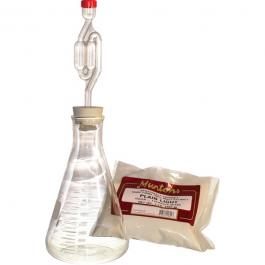 As part of the continued deep dive into specific ingredients and techniques (so far we have dug deeper into yeast and reviewed water treatment) I thought a further post on yeast was in order especially given the cost of quality yeast. Its expensive.
As part of the continued deep dive into specific ingredients and techniques (so far we have dug deeper into yeast and reviewed water treatment) I thought a further post on yeast was in order especially given the cost of quality yeast. Its expensive.
As I mentioned in an earlier post on why I brew, its not just the pleasure of drinking high quality fresh ale, or the enjoyment of simply brewing, but also the lower cost of home made ale that stokes my passion for homebrew. Brewing your own real ale is very economical. I was reminded as I toured the liquor store today and noticed a 6 pack of Fullers ESB on the shelf for $12 (or $2 a bottle), and remembered I have 2 cases (48 bottles) of my own version (though still not up to Fullers quality) in my cellar that cost me approx $4.75 per 6 pack ($0.79 per bottle). Given I like to use the more expensive liquid yeast from Wyeast or White Labs I find yeast is the most expensive ingredient in my brews. These yeasts have reliable attenuation percentages and produce very consistent results every brew. I have never had a bad batch. But they are expensive, most being over $6 a packet. What also doesn’t help is I am often left guessing what type of yeast to purchase for a recipe, e.g. is it a London Ale, London Ale III, or a Thames Valley strain?
But what if I could get the right yeast and pay nothing (except for the one time cost of a single bottle of beer). I could bring the price of a 6 pack of Fullers ESB down to $4 (or $0.66 per bottle) helping my budget somewhat and deliver an even closer match to the original I am trying to clone.
This brings me to the main reason for the visit to my local quality liquor store (as I rarely buy beer except for research purposes), to acquire a sample of 2007 bottle conditioned Fullers Vintage Ale. As noted in my prior post, I am unhappy with the results of version 1.0 of my Fullers ESB clone. As part of my research into figuring out how to improve the recipe I have been investigating how to improve the malt, hops and yeast mix. I have managed to finally find a reliable source for the appropriate hops but got stuck on the yeast. Fullers, like most breweries, is very secretive around its yeast as so much of the flavour and character of the finished ale comes from it. During my research I was browsing some recipe web sites and found a post on a bulletin board where a homebrewer from England was trying to replicate Fullers London Pride using some yeast grown from a yeast sample he had lifted from some bottle conditioned Fuller 1845 Ale. Much like homebrew, bottle conditioned commercial beers are naturally carbonated in the bottle using residual yeast and priming sugar leaving a sediment on the bottom of the bottle. The sediment is rich with yeast cells and, with a little care and attention, these cells can be reactivated and grown to be used again in whatever beer you choose. In my case any Fullers clone I might make in the future.
But isn’t all beer sold in the USA pasteurized? I always thought so. So what commercial beers are out there that we could use to create our own free supply of yeast? The answer appears to be not many. As a rule almost all imported bottled and keg beers are pasteurized, the reason given to preserve freshness and enhance shelf life (though this point in hotly debated, I can attest to having regular gravity beers in my cellar for months and they continue to improve with age). Furthermore almost all domestic US bottled beer is also pasteurized though domestic US keg beer is typically unpasteurized and “fresh” (with the exception of the mega-breweries such as Bud who pasteurize everything). But recently the rules appear to be slowly changing. It is now possible to get imported and domestic bottled conditioned ales for higher gravity brews. I have noted Ringwood, Fullers 1845, Fullers Vintage Ale, and Sam Smiths Organic Ale from the UK and Shipyard Barleywine and Sierra Nevada from the US all available unpasteurized and bottled conditioned in the US market.
So how do we take a sample of bottled conditioned ale and re-culture it for use in your typical 5 gallon batch of homebrew?
- First acquire some bottled conditioned ale that matches either the style you are shooting for or from the same brewery that brews the ale you are attempting to clone (chances are its the same strain)
- Pour yourself a drink, make sure to save ~20% of the ale bottle, including all the sediment from the bottom
- Assemble the following to make a “yeast starter” :
- Sanitized 1 gal carboy or flask, stopper and airlock
- 1/2 cup of Dry Wheat Malt Extract
- 1/2 tsp yeast nutrient (optional)
- A couple of hop pellets (try to use the bittering hop from the ale you are trying to clone)
- In a saucepan bring to a boil 8 oz of water, add Wheat DME and the hop pellets and boil for a total of 10mins
- After 8 mins add yeast nutrient (optional)
- Cool rapidly, I partially submerge the saucepan in a sink full of ice cold water and stir vigorously, this also aerates the liquid
- Once the liquid is cooled to 80ºF pour into a clean, sanitized flask or carboy
- Add the remaining 20% of the bottle conditioned ale, including sediment, from the bottle you purchased
- Insert stopper and airlock and keep at a constant 68-75ºF. The yeast should come back to life within 3-4 days.
Once the yeast is active you can either use it or place in the refrigerator to sleep. Make sure to keep some back to re-culture again for another brew. Yeast can stay healthy for up to 3 months in the fridge, so make sure to re-culture a batch before 3 months to keep the strain alive or you will just have to go out and actually BUY beer, how does that work with the budget!
Other resources:
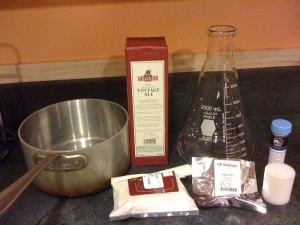
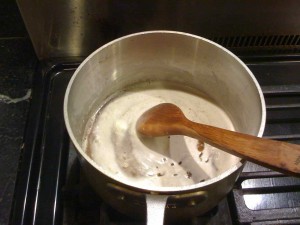

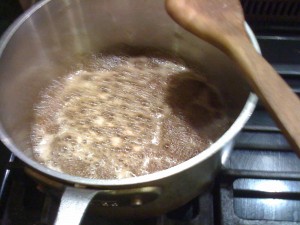
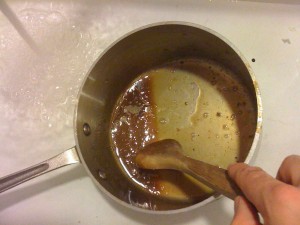
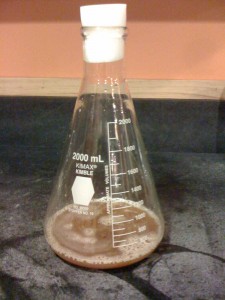
Pingback: British Brewer » Blog Archive » Recipe: Fullers London Pride (version 1.0)()
Pingback: British Brewer » Blog Archive » Tips and Tricks: Buying Hops()